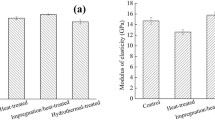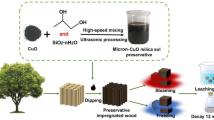Abstract
Rosin was used to improve the physical and mechanical properties of fast-growing poplar wood using the impregnation method. The rosin was dissolved in ethanol with different concentrations and the wood was impregnated with the solutions obtained. The weight percent gain, density, equilibrium moisture content (EMC), anti-swelling efficiency (ASE), and mechanical properties of the treated wood were measured in detail. The crystalline structure, morphology, rosin distribution, and dynamic wettability were also evaluated. Results showed that the density of the wood increased from 0.34 to 0.44 g/cm3 after the treatment with 20 % rosin solution. When the rosin content increased by 5, 10, 15 and 20 %, the ASE after 5 days water immersion increased to 15.6, 20.6, 30.3 and 36.0 % and EMC reduced by 17.8, 26.5, 36.2 and 42.7 %, respectively. Particularly, the modulus of rupture, modulus of elasticity, and compression strength of the 20 % rosin impregnated wood increased by 12.8, 18.9, 31.6 %, respectively. In addition, the dynamic wettability of wood was significantly changed by the rosin treatment. The rosin within wood could occupy the wood lumens, cell corners, and middle lamella, and partly penetrated wood cell walls, which was revealed by field emission scanning electron microscope and confocal laser scanning microscope.






Similar content being viewed by others
References
Banks W (1973) Water uptake by scots pine sapwood, and its restriction by the use of water repellents. Wood Sci Technol 7:271–284
Belgacem MN, Gandini A (2008) Monomers, polymers and composites from renewable resources. Elsevier, Amsterdam
Dahlen J, Nicholas DD, Schultz TP (2008) Water repellency and dimensional stability of southern pine decking treated with waterborne resin acids. J Wood Chem Technol 28:47–54
De Vetter L, Stevens M, Van Acker J (2009) Fungal decay resistance and durability of organosilicon-treated wood. Int Biodeterior Biodegrad 63:130–134
Deka M, Saikia C (2000) Chemical modification of wood with thermosetting resin: effect on dimensional stability and strength property. Bioresour Technol 73:179–181
Dong Y, Yan Y, Zhang S, Li J (2014) Wood/polymer nanocomposites prepared by impregnation with furfuryl alcohol and nano-SiO2. BioResources 9:6028–6040
Dong Y, Yan Y, Zhang S, Li J, Wang J (2015) Flammability and physical-mechanical properties assessment of wood treated with furfuryl alcohol and nano-SiO2. Eur J Wood Prod 73:457–464
Esteves B, Nunes L, Domingos I, Pereira H (2014) Improvement of termite resistance, dimensional stability and mechanical properties of pine wood by paraffin impregnation. Eur J Wood Prod 72:609–615
Hill CAS (2006) Wood modification: chemical, thermal and other processes. Wiley, Chichester
Klüppel A, Mai C (2013) The influence of curing conditions on the chemical distribution in wood modified with thermosetting resins. Wood Sci Technol 47:643–658
La Mantia FP, Morreale M (2011) Green composites: a brief review. Compos Part A 42:579–588
Lee CM, Lim S, Kim GY, Kim D, Kim DW, Lee HC, Lee KY (2004) Rosin microparticles as drug carriers: influence of various solvents on the formation of particles and sustained-release of indomethacin. Biotechnol Bioprocess Eng 9:476–481
Li JZ, Furuno T, Zhou WR, Yu ZM (2005) Properties of colloidal silica-fixed and propionylated wood composites (I): preparation and dimensional stability of the composites. J Wood Chem Technol 25:245–255
Li JZ, Furuno T, Zhou WR, Ren Q, Han XZ, Zhao JP (2009) Properties of acetylated wood prepared at low temperature in the presence of catalysts. J Wood Chem Technol 29:241–250
Liu X, Xin W, Zhang J (2009) Rosin-based acid anhydrides as alternatives to petrochemical curing agents. Green Chem 11:1018–1025
Lux C, Szalay Z, Beikircher W, Kovacik D, Pulker HK (2013) Investigation of the plasma effects on wood after activation by diffuse coplanar surface barrier discharge. Eur J Wood Prod 71:539–549
Ma Q, Liu X, Zhang R, Zhu J, Jiang Y (2013) Synthesis and properties of full bio-based thermosetting resins from rosin acid and soybean oil: the role of rosin acid derivatives. Green Chem 15:1300–1310
Mansouri HR, Pizzi A, Leban JM, Delmotte L, Lindgren O, Vaziri M (2012) Causes for the improved water resistance in pine wood linear welded joints. J Adhes Sci Technol 25:1987–1995
Nguyen TTH, Li S, Li J (2013a) The combined effects of copper sulfate and rosin sizing agent treatment on some physical and mechanical properties of poplar wood. Constr Build Mater 40:33–39
Nguyen TTH, Li S, Li J, Liang T (2013b) Micro-distribution and fixation of a rosin-based micronized-copper preservative in poplar wood. Int Biodeterior Biodegrad 83:63–70
Nirmala R, Woo-il B, Navamathavan R, Kalpana D, Lee YS, Kim HY (2013) Influence of antimicrobial additives on the formation of rosin nanofibers via electrospinning. Colloid Surf B 104:262–267
Noel M, Fredon E, Mougel E, Masson D, Masson E, Delmotte L (2009) Lactic acid/wood-based composite material. Part 1: synthesis and characterization. Bioresour Technol 100:4711–4716
Pandey K (1999) A study of chemical structure of soft and hardwood and wood polymers by FTIR spectroscopy. J Appl Polym Sci 71:1969–1975
Pizzi A, Mansouri HR, Leban JM, Delmotte L, Pichelin F (2012) Enhancing the exterior performance of wood joined by linear and rotational welding. J Adhes Sci Technol 25:2717–2730
Scholz G, Militz H, Gascón-Garrido P, Ibiza-Palacios MS, Oliver-Villanueva JV, Peters BC, Fitzgerald CJ (2010) Improved termite resistance of wood by wax impregnation. Int Biodeterior Biodegrad 64:688–693
Sun Q, Yu H, Liu Y, Li J, Lu Y, Hunt JF (2010) Improvement of water resistance and dimensional stability of wood through titanium dioxide coating. Holzforschung 64:757–761
Trey SM, Netrval J, Berglund L, Johansson M (2010) Electron-beam-initiated polymerization of poly(ethylene glycol)-based wood impregnants. ACS Appl Mater Inter 2:3352–3362
Trey S, Jafarzadeh S, Johansson M (2012) In situ polymerization of polyaniline in wood veneers. ACS Appl Mater Inter 4:1760–1769
Vukusic SB, Katovic D, Schramm C, Trajkovic J, Sefc B (2006) Polycarboxylic acids as non-formaldehyde anti-swelling agents for wood. Holzforschung 60:439–444
Wang F, Kitaoka T, Tanaka H (2003) Supramolecular structure and sizing performance of rosin-based emulsion size microparticles. Colloid Surf A 221:19–28
Xie Y, Fu Q, Wang Q, Xiao Z, Militz H (2013) Effects of chemical modification on the mechanical properties of wood. Eur J Wood Prod 71:401–416
Yan Y, Dong Y, Li C, Chen H, Zhang S, Li J (2014) Optimization of reaction parameters and characterization of glyoxal-treated poplar sapwood. Wood Sci Technol 49:241–256
Zhu Y, Wang W, Cao J (2014) Improvement of hydrophobicity and dimensional stability of thermally modified southern pine wood pretreated with oleic acid. BioResources 9:2431–2445
Acknowledgments
This research was supported by “The Fundamental Research Funds for the Central Universities” (No. TD2011-12) and Special Fund for Forestry Research in the Public Interests (Project 201204702).
Author information
Authors and Affiliations
Corresponding author
Rights and permissions
About this article
Cite this article
Dong, Y., Yan, Y., Wang, K. et al. Improvement of water resistance, dimensional stability, and mechanical properties of poplar wood by rosin impregnation. Eur. J. Wood Prod. 74, 177–184 (2016). https://doi.org/10.1007/s00107-015-0998-6
Received:
Published:
Issue Date:
DOI: https://doi.org/10.1007/s00107-015-0998-6




